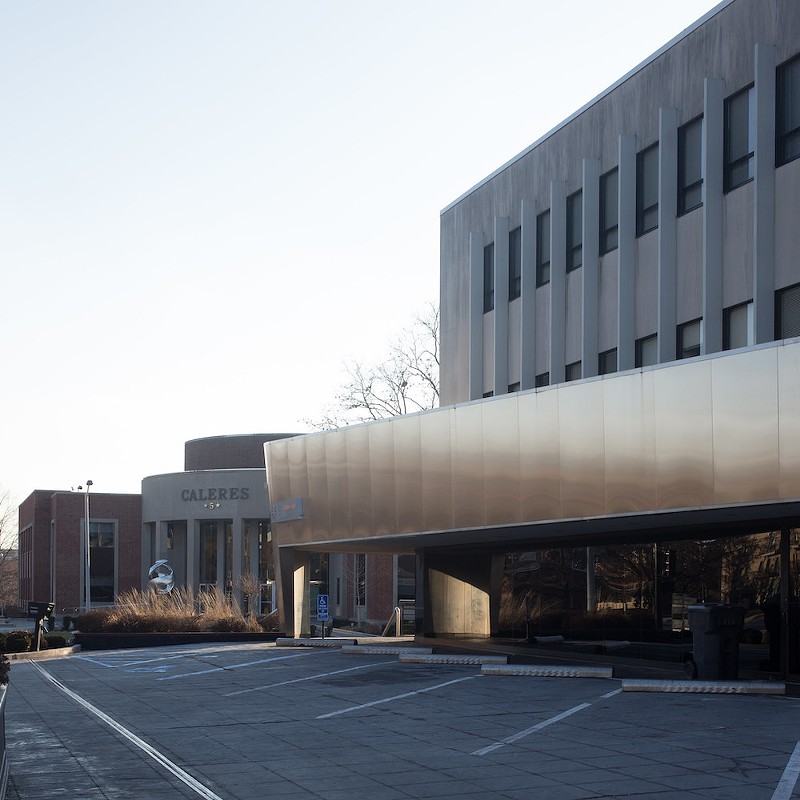
This column was first published in Ray Hartmann's St. Louis Insider.
If jumping to conclusions were a track-and-field sport, Clayton would be favored to win state.
All hell broke loose last week after the Clayton Board of Education surprised residents with the news it was buying a 9-acre property adjacent to its high school. The purchase included the building at 8300 Maryland Avenue that’s served as headquarters to Caleres, formerly known as Brown Shoe Company, since 1952.
Almost no details of the purchase are known. Customarily, the next thing to happen would be for those details to become available. Then, angry residents might grab torches and pitchforks and head for the next school board meeting.
They’ve skipped step two in Clayton. Without the benefit of facts and animated mostly by false hypotheticals envisioning an economic development utopia, many folks are certain that whatever it is they don’t know will be devastating to them.
This has caused the greatest ruckus in Clayton since 2020, when a teenaged girl who had been exposed to COVID-19 went to the Father-Daughter Dance at the Ritz-Carlton. That was believed by some at the time to have unleashed the global pandemic.
At press time, it’s not clear whether this instance might even be worse, because the citizenry doesn’t simply have a grasp of the danger at hand. Somewhat like the coronavirus was in 2020, but maybe not exactly.
I’m a parent in the Clayton School District. And I’m a 37-year panelist on the local PBS talk show Donnybrook, where speaking passionately without the benefit of facts is often what we do.
So, I feel doubly entitled to weigh in here. Allow me to present “five facts to ponder while we wait for other facts to arrive”:
FACT 1: There’s a huge difference between bad messaging and bad policy from a school district.
This fiasco began with an unfortunate public letter from Superintendent Nisha Patel. I only know Patel from seeing her every morning outside of Clayton High School, greeting students alongside the principal, back when I would drop off my kids. She’s good at that sort of communication, which matters.
The letter spoke of an “Empowerment Campus Project.” It employed the language of educators, which many of us don’t speak. It was a self-inflicted wound — well-skewered by my esteemed colleague Bill McClellan — and an apology followed.
Allow me to add a gentle thought to those upset by “how this was handled”: Get over it. The choice of words was bad, not the intentions. I won’t defend the idea of an empowerment campus because I don’t know what that is. But it’s perfectly reasonable — actually, responsible — for a landlocked school district to consider acquiring adjacent property.
Recent declines in enrollment cannot be assumed to be permanent. The need for more or better classroom or meeting space, or outdoor space, is always a possibility. So is security. And, for that matter, so is protecting the high school from less-than-great neighboring usage. Say, nightlife.
As to the secrecy surrounding the purchase, it was a real-estate transaction likely governed by confidentiality clauses. I care about the Sunshine Law as much as the next guy, but it doesn’t apply to real estate transactions during the negotiations stage.
FACT 2: For those in Clayton outraged by schools “taking property off the tax rolls,” I offer two words: Washington University.
The Caleres property at 8300 Maryland Avenue is listed in St. Louis County property tax rolls at $33.5 million in appraised value and $10.7 in assessed value. Somehow, those numbers went up more than 40 percent in the past year, as did Caleres’ tax payment of $ 1,032,155.71. (The company has been paying under protest for years.)
The $1 million figure is presumably why, as part of the rage against the machine known as the Clayton School District, people have claimed irrationally “this is costing the city $1 million a year in property taxes!”
That number is grossly misleading. You can see here at the city of Clayton website how property tax dollars are broken down. The largest amount of Caleres’ tax bill would go to the school district itself, which obviously would have factored that into the numbers of its real estate transaction.
As for the city of Clayton, the worst case is that it might suffer a loss of one-quarter of one percent of its $40 million annual operating budget. That could mean slightly more than $100,000, which is something, but hardly a major hit. And because property tax math is way complicated, it’s possible the city wouldn’t lose out at all.
Now, if you want to talk millions, contrast the outrage over this one little purchase to the never-to-be-questioned real-estate empire of Washington University. You hear a lot complaining about this — mostly in private — from officials in University City. But none of their counterparts in Clayton breathes a word.
Just a cursory review of county property tax records — I may do a deeper dive later — shows that Washington University property within Clayton’s borders adds up to at least $193.2 million in appraised value and more than $61.8 million in assessed value. That’s more than six times the value of the Caleres 9-acre property.
According to county tax records, the university does pay taxes for a few properties on Forsyth Boulevard. But like the school district, it’s largely tax exempt.
That’s perfectly fine, and Clayton is lucky to have the university’s West Campus where the old Famous-Barr once stood. But there’s a pretty clear double standard here.
In other communities, folks might ask a wealthy institution like Washington University to make PILOT payments. That stands for “Payments in lieu of taxes.” But not in this region, and certainly not in Clayton.
So, unless and until that happens, spare me the drama about the Caleres purchase.
FACT 3: If these nine acres were so ideal to develop, they would already have been purchased from Caleres by developers (without a need for incentives).
This is the stupidest part of the furor. We’re told that multiple, large, respected developers have negotiated with Caleres — and apparently had discussions with Clayton officials — about exciting new economic development on the parcel adjacent to the high school. Apparently, Caleres chose to sell to the school district instead, which is arguably not the fault of the Board of Education.
We have no facts about these development plans, though. Well, none other than that negotiations with Caleres “fell through.” And, of course, that the projects were certain to have been truly transformational. If only the numbers worked, which they didn’t.
Call me cynical, but there’s only one reason for multiple developers — whose negotiations fell through — to go on the airwaves after the fact (as at least two have) to complain about the school having acquired the property. That reason would be to leverage a better deal from the city government — meaning corporate welfare — so that the numbers might work out a little better for them.
Well, if you’ve followed my work, you know I have a simple formula for determining how much a wealthy community should allocate for such incentives: You take the number “zero” and multiply it by whatever the f*** you want.
It has been suggested that Clayton would benefit immeasurably from a “mixed use” development with more residents and more nightlife. I wasn’t aware that Clayton was starving for either, but what high school administrator doesn’t want some bars, or perhaps live music (there seems to be a void for hip-hop in Clayton) next door to their premises?
Whoever runs the numbers will pretend there’s no cannibalization effect — wherein subsidized new developments weaken or kill existing businesses that have been generating taxes for decades. Like Ballpark Village did. And like a new development in Clayton surely would even if no one’s keeping score.
I was intrigued by one part of the developers’ case: They claim their new utopia would provide Clayton a new “front door.” That is, unless you headed to town from some direction other than the west. Then it would be a new back door, or a new side door.
FACT 4: The old Brown Shoe building has historic value, and its preservation should be given full consideration.
I believe I’m the first to raise the matter of historic preservation, mainly because I had noticed the Brown Shoe headquarters building was born the same year I was. That hardly makes it historic, but it does mean that it’s old.
So, I decided to inquire with an expert, and it turns out that at the very least, serious consideration should be given to preserving the structure. I highly doubt that was part of any developer’s plan. But it could be an ideal use for the school district.
That’s the view of John C. Guenther, president of the St. Louis chapter of the Society of Architectural Historians. Between Guenther and I, we’ve received one fellowship from the American Institute of Architects “for notable contributions to the advancement of the profession of architecture in design.”
So, he has the floor. And here’s what Guenther has to say about the building at 8300 Maryland Avenue in Clayton:
“The building is a great example of Mid-Century Modern architecture for a corporate headquarters. It is thought to have been designed by the architectural firm of Russell, Mullgardt, Schwartz & Van Hoefen, which traces origins to 1900, and was for decades St. Louis’ largest architectural practice.
“The building design features a welcoming and dignified entrance rotunda facing northeast. The two-story form of the building is nicely scaled, fronting onto Maryland Avenue, with a landscaped setback, and fitting beautifully and skillfully into the neighborhood and urban context.
“Should the Clayton School District acquire the Caleres Headquarters Building and site, with the intent to house academic programs on this site, there are numerous opportunities to explore, through saving and adaptively reusing this headquarters building.
“In doing so, the urban fabric and scale of the building and its neighborhood would be maintained. And importantly, our history would not be lost and sent to a landfill. There is a rich history here, both architectural and social, to be cherished and studied further. It can remain and serve us well, now and into the future.
"’Measure twice, cut once’ as the carpenters' saying goes. Do the adaptive reuse study first to see how this building might serve the Clayton School District, now and for generations to come.”
FACT 5: Clayton and its school district have an excellent relationship that deserves better than a furor without facts.
In 2019, a group calling itself “Citizens for Clayton Schools” advanced a volunteer campaign in support of a tax-increase proposition. In a tough environment, it received 64 percent of the vote. I knew about the unusual passion of the residents because one of my closest friends, Chip Casteel, was co-chair of the effort.
So, it really struck me to hear citizens become so prematurely enraged. Colleague Charlie Brennan, another close friend (although he might deny it), is a leader of that effort. I can vouch for his good intentions.
I assume as much can be said for the four ex-mayors who fired off a public letter attacking the schools’ Caleres purchase as “unwise to the extreme” and “an unnecessary and unwarranted government intrusion.”
It was neither. For its part, the Clayton School District owes those residents two things: Great public education and responsible stewardship of public funds. There’s nothing so far in this controversy to suggest it has failed at either.
The district has absolutely no obligation to sit by, arguably to its own detriment, while powerful developers try to finagle their best deal for the property next door. But as I believe I’ve suggested ad nauseam, we might want to wait for the facts to arrive.
I hadn’t realized, until researching this, that Caleres is not a new company, nor one that acquired the venerable Brown Shoe Company. It’s actually the same company, a great, national leader in its day, that helped put St. Louis on the map — “First in booze, first in shoes, last in the American League.”
The company decided in 2015 to change its name to “Caleres.” I had to go to Wikipedia to learn what that was about.
Caleres comes from the Latin word calere which means “to glow with passion or intensity.” Well, that’s certainly fitting for this occasion.
I think they should go back to calling themselves the Brown Shoe Company. And Clayton should harken to more rational times as well.
Ray Hartmann founded the Riverfront Times. Read his insights by subscribing to Ray Hartmann's St. Louis Insider on Substack.
Subscribe to Riverfront Times newsletters.Follow us: Apple News | Google News | NewsBreak | Reddit | Instagram | Facebook | Twitter | Or sign up for our RSS Feed





